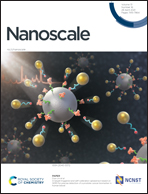Interfacial Dzyaloshinskii–Moriya interaction in the epitaxial W/Co/Pt multilayers†
Abstract
The Dzyaloshinskii–Moriya interaction (DMI) manifesting in asymmetric layered ferromagnetic films gives rise to non-colinear spin structures stabilizing magnetization configurations with nontrivial topology. In this work magnetization reversal, magnetic domain alignment, and strength of DMI are related to the crystalline structure of W/Co/Pt multilayers grown by molecular beam epitaxy. The applied growth method enables the fabrication of layered systems with higher crystalline quality than commonly applied sputtering techniques. A relatively high value of the D coefficient was determined from the aligned magnetic domain stripe structure, substantially exceeding 2 mJ m−2. The highest value of DMI strength Deff = 2.64 mJ m−2 and surface DMI parameter DS = 1.83 pJ m−1 have been observed for a repetition number equal to 10. The experimental results correlate exactly with those obtained from the micromagnetic modelling and density functional theory calculations performed for the well-defined layered stacks. This high value of DMI strength originates from the additive contributions of the interfacial atomic Co layers at the two types of interfaces.



 Please wait while we load your content...
Please wait while we load your content...